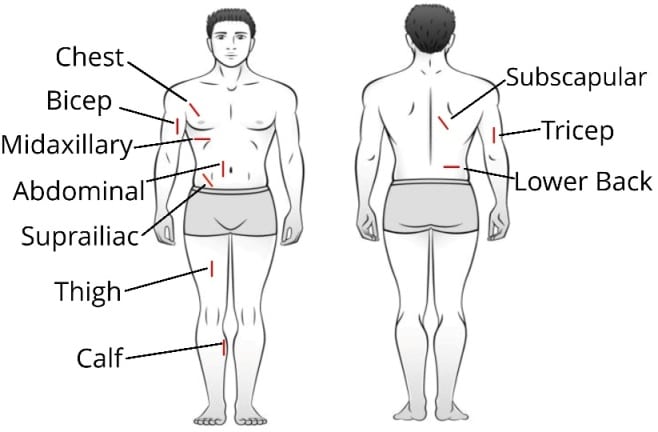Body Fat Percentage Calculator
Calculate your body fat percentage using different methods
The US Navy Method uses neck, waist and hip circumferences to estimate body fat percentage. It’s easy to perform at home with just a measuring tape.
Your Results
Body Fat Percentage:
Classification:
Body Fat Category Chart
| Category | Men | Women |
|---|---|---|
| Essential Fat | 2-5% | 10-13% |
| Athletes | 6-13% | 14-20% |
| Fitness | 14-17% | 21-24% |
| Average | 18-24% | 25-31% |
| Obese | 25%+ | 32%+ |

1. Chest
Take a diagonal fold halfway between the nipple and upper armpit.
2. Midaxillary
Take a horizontal fold directly below the armpit at a point on the midaxillary line
3. Biceps
Take a vertical fold on the front of the upper arm, midway between the shoulder and the elbow.
4. Triceps
Take a vertical fold on the back of the upper arm, midway between the shoulder and the elbow.
5. Subscapular
Take a diagonal fold directly below the shoulder blade.
6. Abdominal
Take a vertical fold about 2 cm to the right of the navel.
7. Suprailiac
A diagonal fold should be taken above the iliac crest.
8. Thigh
Take a vertical fold on the front of the thigh, midway between the hip and the knee, with the foot flat on the ground.
9. Lower back
Take a diagonal fold at the level of the iliac crest, slightly to the right of the spine.
10. Calf
Take a vertical fold on the inside of the leg, at the widest part of the calf muscle.
Body Fat Percentage Calculator
Calculate your body fat percentage using scientifically validated methods. Research shows that body fat percentage is a more accurate health indicator than BMI or weight alone, providing deeper insights into your overall health and fitness.
Research-backed: Multiple studies confirm that body composition metrics, particularly body fat percentage, are strongly associated with overall health outcomes and disease risk. Scientific evidence shows measuring body fat can help track fitness progress, assess health risks, and guide nutrition and exercise decisions more effectively than weight or BMI alone.
Interactive calculator will appear here when implemented. Choose from multiple scientifically-validated methods including US Navy, Jackson-Pollock, and more.
Why Body Fat Percentage Matters More Than Weight
Body fat percentage is a critical health metric that measures the proportion of fat mass to total body weight. Unlike simple weight measurements or BMI calculations, body fat percentage provides deeper insights into your overall health and fitness level.
Research published in BMC Musculoskeletal Disorders shows that excess body fat, particularly visceral fat, is strongly associated with various health concerns including musculoskeletal pain, cardiovascular disease, and metabolic disorders.
Body Composition Assessment
Studies show that body fat percentage provides a more accurate representation of health status than BMI. Two individuals with identical BMI can have dramatically different health profiles depending on their body fat percentage and distribution.
Health Risk Prediction
Research indicates that body fat percentage and distribution are stronger predictors of health risks than total body weight. Visceral fat in particular is associated with increased inflammation and metabolic dysfunction.
Fitness Progress Tracking
Body fat measurements help distinguish between fat loss and muscle gain, providing more meaningful insight into fitness progress than scale weight, which can remain unchanged even during significant body composition improvements.
How Our Body Fat Calculator Works
Our comprehensive calculator implements multiple scientifically-validated formulas to estimate your body fat percentage:
- US Navy Method - Using circumference measurements of specific body parts
- Jackson-Pollock Methods - Including 3-site, 4-site, and 7-site skinfold measurements
- Parrillo 9-Site Method - Using comprehensive skinfold measurements for enhanced accuracy
- Durnin-Womersley Method - Age and gender-specific equations for reliable results
According to research published in the Journal of Exercise Science & Fitness, these methods provide reliable estimations when properly applied.
Know Your Body Fat Percentage Results
| Classification | Women | Men |
|---|---|---|
| Essential Fat | 10-13% | 2-5% |
| Athletes | 14-20% | 6-13% |
| Fitness | 21-24% | 14-17% |
| Acceptable | 25-31% | 18-24% |
| Obese | >32% | >25% |
These classifications are based on guidelines from the American Council on Exercise and represent general health benchmarks across different fitness levels.
Health Implications of Body Fat Percentage
Research has established clear links between body fat percentage and various health outcomes:
Metabolic Health
Excess body fat disrupts hormone balance and function, particularly affecting insulin sensitivity and increasing the risk of type 2 diabetes. Maintaining healthy body fat levels improves metabolic parameters including blood glucose control.
Cardiovascular Risk
Visceral fat produces inflammatory cytokines that increase cardiovascular disease risk, raising "bad" LDL cholesterol while lowering "good" HDL cholesterol. Reducing excess body fat significantly improves cardiovascular health markers.
Musculoskeletal Impact
A systematic review in BMC Musculoskeletal Disorders found significant associations between higher body fat percentages and various musculoskeletal pain conditions, including joint pain and reduced mobility.
Longevity
According to research published in PubMed, maintaining optimal body composition is associated with increased life expectancy and improved quality of life through reduced disease burden.
Body Fat Measurement Methods Explained
US Navy Method
The US Navy Method uses circumference measurements of the neck, waist, and hips (for women) along with height to estimate body fat percentage. It's simple, accessible, and doesn't require specialized equipment.
Skinfold Caliper Methods
Skinfold measurements evaluate subcutaneous fat at specific body sites. The accuracy increases with the number of measurement sites:
- 3-Site Method: Measures chest, abdomen, and thigh for men; triceps, suprailiac, and thigh for women
- 4-Site Method: Adds subscapular measurements for enhanced accuracy
- 7-Site Method: Comprehensive approach measuring chest, midaxillary, triceps, subscapular, abdomen, suprailiac, and thigh
- Parrillo 9-Site Method: Adds biceps, lower back, and calf measurements for maximum precision
Research from Journal of Exercise Science & Fitness validates these methods for accurate body composition assessment when performed correctly.
Optimal Body Fat Percentages by Age and Gender
Healthy body fat percentages vary by age and gender. Women naturally maintain higher essential fat levels for hormonal function and potential childbearing. Body fat percentage typically increases with age for both genders.
| Age Group | Women (Healthy Range) | Men (Healthy Range) |
|---|---|---|
| 20-29 | 16-28% | 7-17% |
| 30-39 | 17-29% | 12-21% |
| 40-49 | 20-30% | 14-23% |
| 50+ | 22-31% | 16-24% |
Strategies to Reduce Body Fat Percentage
If your body fat percentage falls outside the recommended range, consider these evidence-based approaches:
Strength Training
Resistance exercises increase muscle mass, boosting metabolic rate and enhancing fat oxidation. Aim for 2-3 sessions weekly, focusing on compound movements like squats, deadlifts, and bench presses.
High-Intensity Interval Training (HIIT)
Research shows HIIT produces superior fat loss results compared to steady-state cardio while requiring less time. Include 2-3 HIIT sessions weekly for optimal results.
Nutrition Optimization
Create a moderate caloric deficit (300-500 calories below maintenance) while maintaining adequate protein intake (1.6-2.2g per kg of body weight) to preserve lean muscle mass during fat loss.
Sleep and Stress Management
Poor sleep and chronic stress elevate cortisol levels, promoting fat storage, particularly visceral fat. Prioritize 7-9 hours of quality sleep and implement stress-reduction techniques.
Functions of Body Fat
Energy Storage
Body fat serves as the body's primary energy reserve, storing calories for use during periods of caloric deficit or increased energy demands.
Hormone Regulation
Adipose tissue produces and regulates various hormones, including leptin and adiponectin, which influence metabolism, appetite, and insulin sensitivity.
Protection
Body fat provides cushioning and protection for vital organs against physical trauma and environmental changes.
Insulation
Subcutaneous fat helps maintain body temperature by providing thermal insulation, reducing heat loss in cold environments.
Frequently Asked Questions
EXPERT TIP: When measuring body fat percentage, consistency is key. Use the same method, time of day, and conditions for each measurement to track meaningful changes over time.
How accurate is the body fat calculator?
Our calculator provides reliable estimates when used correctly. For maximum accuracy, follow measurement instructions precisely and use the same method consistently to track changes over time. The US Navy method typically has an error margin of 3-4%, while properly performed skinfold measurements can have an error margin of 3-5% compared to gold standard methods like DEXA scans.
How often should I measure my body fat percentage?
For most individuals, measuring body fat percentage every 4-6 weeks provides sufficient data to track progress without obsessing over small fluctuations.
What body fat percentage is needed for visible abs?
Visible abdominal definition typically requires approximately 10-12% body fat for men and 16-20% for women, combined with well-developed core muscles. However, this can vary based on genetics, muscle development, and fat distribution patterns.
Can body fat percentage be too low?
Yes. Body fat percentages below 5% for men and 12% for women can negatively impact hormonal function, immune response, and overall health. Essential fat is crucial for survival and physiological functions.
How is body fat percentage different from BMI?
BMI (Body Mass Index) only considers height and weight, without distinguishing between fat mass and lean mass (muscle, bone, organs). This means a muscular athlete could have an "overweight" BMI despite having low body fat. Body fat percentage directly measures the proportion of your weight that consists of fat tissue, providing a more accurate picture of body composition.
Why do women naturally have higher body fat percentages than men?
Women naturally maintain higher body fat percentages due to biological and evolutionary factors including reproductive function, hormonal differences (particularly estrogen), lower muscle mass, and different fat distribution patterns. The essential fat (minimum for health) is 10-13% for women compared to 2-5% for men.
References and Further Reading
- Walsh TP, et al. (2018). The association between body fat and musculoskeletal pain: a systematic review and meta-analysis. BMC Musculoskeletal Disorders, 19(1), 233.
- Machado-Fragua MD, et al. (2021). Body fat assessed by bioelectrical impedance analysis and incidence of diabetes: A systematic review. Journal of Exercise Science & Fitness.
- Roche AF, et al. (1993). Multisite methods for the investigation of body composition and related risk factors. American Journal of Human Biology.
- American Council on Exercise. (2023). ACE Personal Trainer Manual (6th ed.).
- Gallagher D, et al. (2000). Healthy percentage body fat ranges: an approach for developing guidelines based on body mass index. American Journal of Clinical Nutrition, 72(3):694-701.
